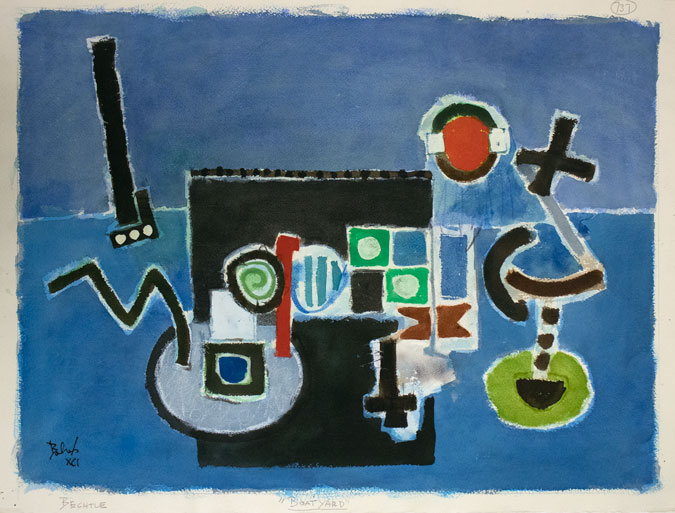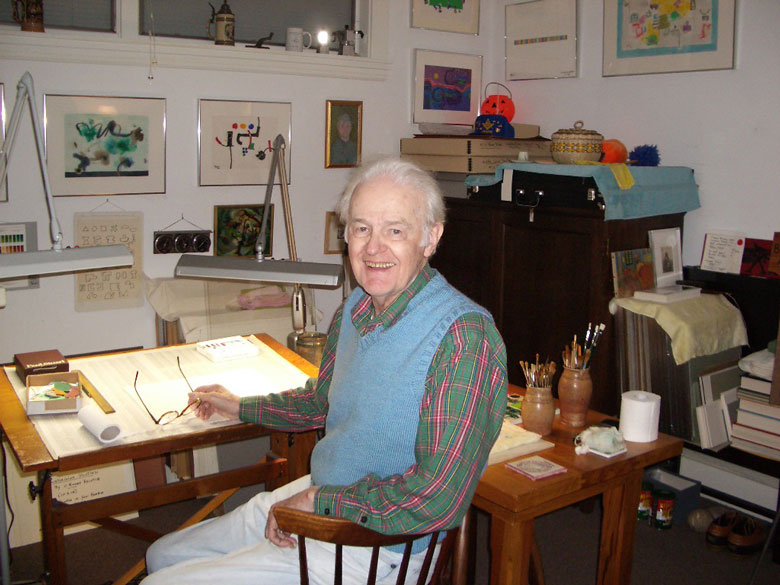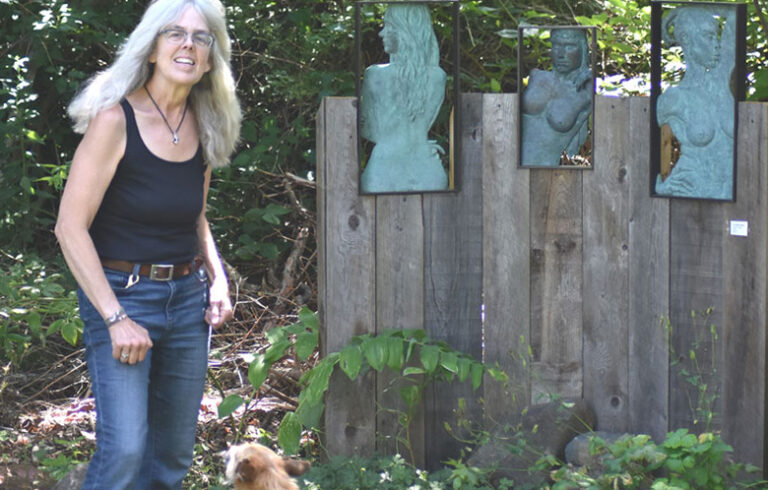
An e-blast from the Farnsworth Art Museum back in July highlighted the acquisition of a watercolor, “Boat Yard,” by C. Ronald Bechtle (1924-2014), a modernist painter who spent time on Mount Desert Island starting in the 1960s. In its communiqué, the museum mentioned that Bechtle’s son, Reid, traced the inspiration for the painting to his father’s visits to the Hinckley Company yard in Southwest Harbor in the early 1990s.
“He was not a boater,” he recalled, “but appreciated the quality of the Hinckley boats.”
Looking at the painting, Reid makes out the contours of buildings and a dock stretching at an angle into the water. He notes that the facility was smaller in 1991, the date of the watercolor. That year Hinckley produced the last of its signature Bermuda 40 fiberglass sailboats.
Bechtle offered an intriguing assortment of symbols and shapes to represent the marine setting, including bright red pennants, a black cross, circles, and squares. These diverse abstract elements are set against a blue background that might be the land and sea, with a horizon line bisecting the picture. No guide to the watercolor’s visual language is required to appreciate its lively yet balanced composition.
“My father loved Maine as he could find the quiet isolation he enjoyed, especially out of season.”
The painting was not part of a defined series, Reid notes, although style-wise it relates to the two other Bechtle watercolors recently added to the Farnsworth collection, “Sea Storm,” from 1987, and “Late June—Just Out There,” 1995. The latter was inspired by his visits by mailboat to the Cranberry Isles to visit artist and writer friends, including Emily Nelligan (1924-2018).
Bechtle started out as a representational artist, painting scenes of life around his home in Philadelphia. Over the years his subjects included still lifes, street scenes, and social-realist images of various figures, including a crowded night club.
After serving in the Army Air Force, Bechtle studied painting at Eastern Tennessee University, Temple University’s Tyler School of Art and Architecture, the Samuel S. Fleisher Art Memorial, and the Philadelphia Museum and School of Industrial Art. He also took private lessons with famed lithographer Benton Spruance (1904-1967) in the 1950s.
While working for the Philco/Ford Corporation, an electronics manufacturer in Philadelphia, Bechtle painted every day. Around 1954, he turned to abstraction, influenced by modernist modes of rendering the world. A few years later he shifted to watercolor, drawn to the “chance effects” the medium presented. His sense of invention grew from there.
Bechtle first came to Maine around 1965. After his wife, Jenny Manchur, passed away in 1962, he remarried. The parents of his second wife, Isabel Korkmazian, had a home in Seal Harbor given to them by David Rockefeller.
Isabel’s mother, Mary, headed up the households for the Rockefellers’ island residences and her father, George, repaired their oriental rugs, a skill he learned in Armenia. The couple worked for the Rockefeller family for 50-plus years.
Upon Isabel’s parents’ death the house passed to the Bechtles. According to Reid, his father spent at least six to eight months of the year in Maine at the Korkmazian home, which he refurbished. He also built an addition for his studio.
“My father loved Maine as he could find the quiet isolation he enjoyed, especially out of season,” Reid recalls. He describes his father as a loner who struggled with personal demons. “He was a gentle man but distant. His life was painting.”
During weeks-long visits nearly every year from 1970 to around 2008, Reid would enjoy breakfast at his father’s favorite Bar Harbor diner. Later, at home in Seal Harbor, the two would sit on the porch and chat over a Scotch before dinner, “but for the most part,” Reid remembers, his father would “steal away and paint most of the day.” The onset of dementia led to his being institutionalized in 2009.
Bechtle never showed in Maine and didn’t exhibit his work beyond the 1970s, his son relates. “He painted for the love of painting,” he said.
The Farnsworth’s acquisition of three of his watercolors will help widen the audience for an artist who found inspiration on the shores of his adopted home.
A selection of Bechtle’s work can be viewed at www.crbechtleart.com. Thanks to Reid Bechtle for responding to questions about his father’s work.
Carl Little’s tribute to Sargent Mountain Pond is featured in Alive to This: Essays on Living Fully by 20 Maine Writers (Littoral Books).





